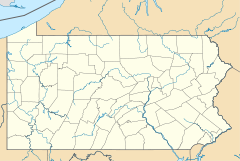- Mercer Museum
-
Mercer Museum
 Mercer Museum
Mercer MuseumLocation: Doylestown, Pennsylvania Coordinates: 40°18′28″N 75°7′38″W / 40.30778°N 75.12722°WCoordinates: 40°18′28″N 75°7′38″W / 40.30778°N 75.12722°W Built: 1904 Architect: Dr. Henry Mercer Architectural style: Colonial Revival, Other Governing body: Private Part of: Fonthill, Mercer Museum, and Moravian Pottery and Tile Works (#85002366) NRHP Reference#: 72001097[1] Significant dates Added to NRHP: March 16, 1972[1] Designated NHLDCP: February 4, 1985[2] The Mercer Museum is a museum located in Doylestown, Pennsylvania, United States, a suburb of Philadelphia. The Bucks County Historical Society operates the museum, as well as the Spruance Library and Fonthill, former home of the museum's founder, archeologist Henry Chapman Mercer. The museum was individually listed on the National Register of Historic Places in 1972,[1] and was later included in a National Historic Landmark District along with the Moravian Pottery and Tile Works and Fonthill. These three structures are the only poured-in-place concrete structures built by Mercer.[2]
Contents
History
Henry Mercer was a gentleman anthropologist. On a cruise up the Ruhr in early adulthood, Mercer was impressed by the eclipse of artisanal culture by industrial production, and resolved himself to preserving artifacts of preindustrial life. In the late 19th and early 20th centuries, Mercer collected pre-industrial hand tools and other implements of the past. He believed that the story of human progress and accomplishments was told by the tools and objects that people used and saw these time-honored crafts slowly disappearing from memory.
Mercer personally designed plans for a museum to house his collection, six stories tall and cast of poured-in-place concrete. Mercer's museum was completed in 1916. In addition to tools, it displays furnishings of early America, carriages, stove plates, a gallows, antique fire engines, a whaleboat, and the Lenape Stone. The Spruance Library, which houses historical research materials, is located on its third floor.
Why concrete?
The museum is one of three poured-in-place concrete structures built by Mercer. The others include his home Fonthill and the Moravian Pottery and Tile Works, both of which are located one mile from the museum.
Mercer decided to build with concrete after the Great Boston Fire of 1872 destroyed his aunt's prized collection of medieval armor, which had been stored in wooden structures. He did not want his own collections to suffer the same fate. Locals mocked his choice of building materials, but on completion of the museum, he lit a bonfire on its roof to prove that it was fireproof [1]. Mercer's museum was an early demonstration of rebar-reinforced concrete as a structural material.
References
- ^ a b c "National Register Information System". National Register of Historic Places. National Park Service. 2009-03-13. http://nrhp.focus.nps.gov/natreg/docs/All_Data.html.
- ^ a b "Fonthill, Mercer Museum, and Moravian Pottery and Tile Works". National Historic Landmark summary listing. National Park Service. http://tps.cr.nps.gov/nhl/detail.cfm?ResourceId=1901&ResourceType=District. Retrieved 2008-07-02.
External links
- Mercer Museum official website
- Panoramic images: exterior, main chamber, stove plate gallery
U.S. National Register of Historic Places Topics Lists by states Alabama • Alaska • Arizona • Arkansas • California • Colorado • Connecticut • Delaware • Florida • Georgia • Hawaii • Idaho • Illinois • Indiana • Iowa • Kansas • Kentucky • Louisiana • Maine • Maryland • Massachusetts • Michigan • Minnesota • Mississippi • Missouri • Montana • Nebraska • Nevada • New Hampshire • New Jersey • New Mexico • New York • North Carolina • North Dakota • Ohio • Oklahoma • Oregon • Pennsylvania • Rhode Island • South Carolina • South Dakota • Tennessee • Texas • Utah • Vermont • Virginia • Washington • West Virginia • Wisconsin • WyomingLists by territories Lists by associated states Other Categories:- Historic district contributing properties
- Museums in Bucks County, Pennsylvania
- History museums in Pennsylvania
- Industry museums in Pennsylvania
- National Historic Landmarks in Pennsylvania
- Buildings and structures completed in 1904
- Biographical museums in Pennsylvania
Wikimedia Foundation. 2010.




